#mainland Australia
Explore tagged Tumblr posts
Text

this week's FUCKING BNUUY FRIDAY is starting to get A LITTLE CHILLY
#cave story#usagi#my ocs#scribblins#FUCKING BNUUY FRIDAY#autumn is starting to swing into action here and boy am i relieved#it's funny how quickly and early in the year it starts cooling down compared to my hometown/mainland australia#i'm told it's normal for here though
42 notes
·
View notes
Text
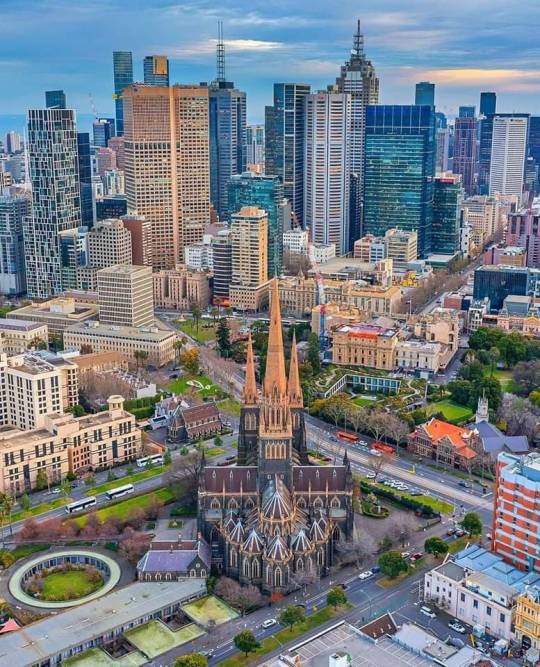
M E L B O U R N E
135 notes
·
View notes
Text



Did I show you ?? How cold it was this morning?
7 notes
·
View notes
Text
reblog for bigger sample size etc
#i wrote this poll when i was in tasmania (first time i'd ever left mainland australia) and forgot to actually post it lol#tumblr polls#travel#internal monologue
8 notes
·
View notes
Text
i knowww i need to wait to see where school take me re: anthropology specialties, but ugghh i keep getting nervous about not knowing where im gonna go. like i wanna know where im gonna live in five years
#ive always wanted to see other countries and live abroad#but being trans in this climate there's an added. pressure. to find somewhere safe. even if it is in the country#and i want to mainly work in museums!! but like. museums that have local focus.#like am i going to be in egypt? am i going to be a classical archaeologist living in greece? what about england? mainland euro?#or ireland? or east asia? or middle east? or australia? or south america? or the freaking arctic#like i could literally go anywhere. there's too many options.
0 notes
Text

Mainland She Oak Skink (Cyclodomorphus michaeli), mother with pups, family Scincidae, eastern Australia
photograph by Ken Griffiths
9K notes
·
View notes
Text
Watching a 2018 David Attenborough documentary about Tasmania, seeing a wallaby hop through the snow, and wondering how things are going in Tassie in Mad Max world.
#it's definitely got a different climate from mainland Australia#reckon I'd try to go there if I could#but I do think New Zealand is the place to stay#just so long as we get to crack open Peter Thiel's bunker and throw him out to fend for himself#piece of citizenship-buying vampire shit
1 note
·
View note
Text

Brush-tailed bettongs (also known as woylies) once inhabited more than 60% of mainland Australia. However, the European colonization of the country brought with it predatory feral cats and foxes, and the destruction of much of the animal’s native grassland and woodland habitats.
Between 1999 and 2010, the species’ population size declined by 90% – a drastic drop that some research suggests may have resulted from the spread of blood parasites, alongside other factors. Today, the brush-tailed bettong is limited to just a few islands and isolated mainland pockets in Southwestern Australia: a mere 1% of its former range.
Marna Banggara
“We are on a mission, if you like, to bring back some of these native species that have gone missing in our landscape since European colonization,” says Derek Sandow, project manager of Marna Banggara, an initiative dedicated to restoring some of the Yorke Peninsula’s historic ecological diversity.
Formerly known as the “Great Southern Ark,” the project, which was launched in 2019 by the Northern and Yorke Landscape Board, was renamed to honor the region’s native Narungga people, who are heavily involved with the initiative.
“Marna in our language means good, prosperous, healthy, and Banggara means country,” says Garry Goldsmith, a member of the Narungga community who works on the project.
The team initially erected a 25-kilometer predator-control fence across the narrow part of the Yorke Peninsula to create a 150,000-hectare safe haven for the first species to be brought back: the brush-tailed bettong, known as yalgiri to the Narungga people. “We’ve reduced fox and cat impacts to a level that’s low enough for these yalgiri to be reintroduced and for them to actually find refuges, find food, and to survive themselves,” says Sandow.
Between 2021 and 2023, the team introduced almost 200 brush-tailed bettongs to the protected area. Sourcing these individuals from various remaining populations across Western Australia helped to “increase the genetic pool,” says Goldsmith.
EcoSystem Engineers
Brush-tailed bettongs feed on bulbs, seeds and insects, but their primary food source is fungi growing underground; to find it, they must dig. “They’re nature’s little gardeners,” says Sandow, “a single yalgiri can turn over two to six tons of soil per year.”
That’s why they’re the first species being reintroduced to the region, he says. All this digging aerates the soil, improves water filtration and helps seedlings germinate – benefitting other animals that rely on the ecosystem.
#australia#decolonisation#woylies#brush-tailed bettong#bettongs#environmentalism#good news#science#environment#nature#animals#conservation#yalgiri#animal welfare#animal conservation#rewilding
2K notes
·
View notes
Text
June 2004: An LGBT rights group sailed to an island off Queensland Australia, and declared it a sovereign kingdom in order to perform same-sex marriages, which were illegal in Australia at the time.
This led to the Australian government formally recognising it as a hostile nation in order to ban pride flags from government buildings.
Despite this, Australian governments did largely act cordially with the Kingdom, with government departments addressing communications to "The Gay Embassy" and acknowledging the Kingdom's mission in a number of letters.
The Gay Kingdom declared peace with Australia in 2017 after same-sex marriage was legalised, and formally re-united with the mainland shortly after.
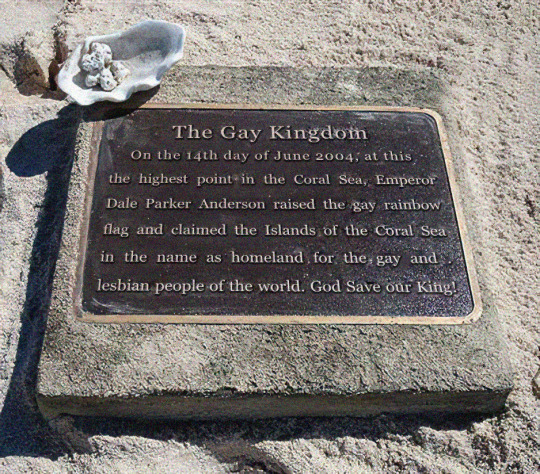
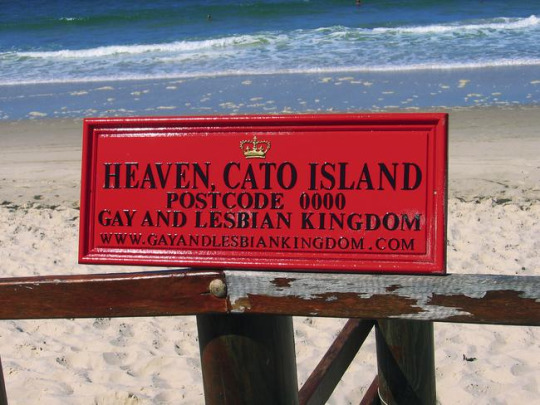
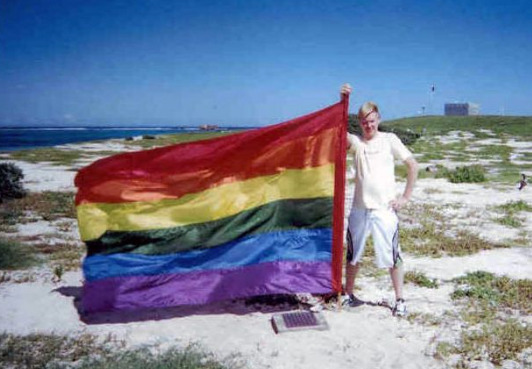
Follow for more batshit moments in Australian politics
9K notes
·
View notes
Text
It's National Dinosaur Day in Australia!
The 7th of May is officially National Dinosaur Day! While our fossil record might be a bit patchier than some continents, there are still plenty of excellent dinosaurs that have been found from the Mesozoic and Cenozoic, and here's a few of them!
Australovenator wintonensis

(art by Scott Reid)
Probably the most iconic Australian dinosaur, Australovenator was a large theropod with massive hooked hand claws from the Winton Formation. It was the first megaraptoran identified in Australia, a group of theropods that we now know were widespread and successful across the southern hemisphere in the Cretaceous!
Kunbarrasaurus ieversi


(art by Ashley Patch)
One of the few armoured dinosaurs found in Australia, Kunbarrasaurus ieversi is known from a beautiful full-body fossil from the Allaru Formation that preserves the armour plates in their life positions!
Dromornis stirtoni

(art by @knuppitalism-with-ue)
The Dromornithidae (also known as mihirungs) have a roughly emu-like body plan but are actually a member of the group Anseriformes, closer to waterfowl! Dromornis stirtoni from the Alcoota Fossil Beds is the largest bird to ever live in Australia that we know of, weighing around half a ton.
Genyornis newtoni
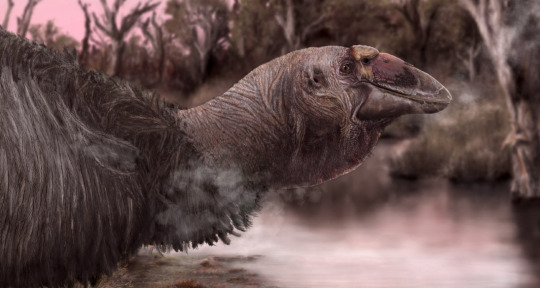
(art by Jacob Blokland)
The latest-surviving mihirung, Genyornis was described in 1896 but the first well-preserved skull fossil of this quarter-ton bird was only published last year by Phoebe McInerney, who I actually know! I also got to do a little bit of work on the second skull of Genyornis in the lab earlier this year so it's not only a cool animal but one I'm especially personally fond of!
Fostoria dhimbangunmal

(art by James Kuether)
Fostoria is a mid-sized iguanodontian that's known from Australia's only ornithischian bone bed, an extremely rare find for a continent whose Mesozoic dinosaur fossils tend to be pretty badly scattered and fragmented. The bones of multiple individuals were found together in the opal fields of the Griman Creek Formation, and the bones themselves had been opalised!
Australotitan cooperensis

(art by Vlad Konstantinov)
Known simply as Cooper for 15 years, Australotitan finally got a full description in 2021 which marked it out as not only Australia's biggest dinosaur but on the scale of some of the largest known sauropods in the world!
Anthropodyptes gilli

(art by,,, Travis Park? I think? this one was a Struggle)
Today the only penguin native to the mainland is the little blue penguin, but in prehistory there were much larger penguins around! They're only known from fragmentary remains in Australia, but species like Anthropodyptes gilli and Pachydyptes simpsoni grew larger than modern emperor penguins!
Diluvicursor pickeringi

(art by Peter Trusler)
One dinosaur we seem to have heaps of in Australia (as with the rest of the world) is small ornithischians. These sprinty little guys are almost ubiquitous in Mesozoic ecosystems, and in Australia Diluvicursor is one of the more complete examples, with a holotype fossil from the Eumeralla Formation that preserves the tail and foot bones.
Phoenicopteridae (Flamingos)
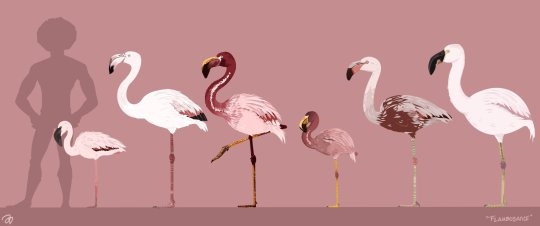
(art by Astrapionte, featuring from left to right: Phoeniconaias proeses, Phoenicopterus copei, Xenorhynchopsis tibialis and minor, Phoenicopterus novaehollandiae, and Phoeniconotius eyrensis)
Last fun fact about Australia, did you know we used to have flamingos until very recently? The flamingo fossil record in Australia is pretty limited, but we know they lived here from the Oligocene all the way to the Pleistocene, when they were likely wiped out by environmental change as the centre of the continent dried up. Phoeniconotius eyrensis seems to have been one of the largest flamingo species, likely heavier than the modern greater flamingo!
371 notes
·
View notes
Text
Byron Bay, Australia: Byron Bay is a beachside town located in the far-northeastern corner of New South Wales, Australia (in Bundjalung Country). It is located 772 kilometres north of Sydney and 165 kilometres south of Brisbane. Cape Byron, a headland adjacent to the town, is the easternmost point of mainland Australia. It is the largest town of Byron Shire local government area, though not the shire's administrative centre (which is Mullumbimby). Wikipedia
220 notes
·
View notes
Text
The Feathertail Glider: this tiny marsupial is the world's smallest gliding mammal, measuring just 6.5-8cm long (not including the tail)
The scientific name of this species is Acrobates pygmaeus (literally "pygmy acrobat") but it's commonly known as the feathertail glider, the pygmy glider, or the flying mouse.

This is the smallest gliding mammal in the world, as its head and body have a combined length of just 6.5-8cm, and its tail measures another 7-8cm long. The tail is fringed on each side with a row of long, stiff hairs that give it a feather-like appearance -- a feature that is not found in any other mammal. This feather-shaped tail acts as a rudder, allowing the tiny marsupial to steer and brake as it glides.

Feathertail gliders struggle to stay warm in harsh conditions, and they must enter a state known as torpor in order to preserve their energy, as this article describes:
A fascinating feature of these tiny mammals is that because they are so small, they have trouble staying warm when it is cold or when there is a food shortage; like the Sugar glider, they enter a state known as torpor.
This means that for short periods, their breathing slows down, and the animal becomes unresponsive; the body temperature drops almost to that of its surroundings. This state is not to be mistaken for hibernation, which is for much longer periods and is not known to occur in marsupials.

This article also adds:
Groups of A. pygmaeus have been observed in practically any available enclosed space, from hollow tree trunks to telephone interchange boxes to bird nests or possum dreys. They form spherical nests (dreys) of vegatation, usually eucalypt leaves, bark and tree-fern fiber. They have been found in groups of up to 20 individuals, but these are not considered stable associations. It is believed that communication between mother and young is through a number of high-frequency sounds and marking with urine.
Feathertail gliders are found only in mainland Australia.
Sources & More Info:
Moonlit Sanctuary: Narrow-Toed Feathertail Gliders
Australian Museum: The Feathertail Glider
Animal Diversity Web: Acrobates pygmaeus
Mammalian Species: A. pygmaeus
Wildlife Information, Rescue, and Education Service: The Feathertail Glider
Wildlife Preservation Society of Queensland: Feathertail Gliders
Rares Foundation: Husbandry Guidelines for Feathertail Gliders (PDF)
#not an artifact#not an arthropod#just a tiny flying possum#with a feather for a tail#acrobates pygmaeus#feathertail glider#pygmy glider#marsupials#possums#gliders#mammals#animal facts
110 notes
·
View notes
Note
Your post on bluey mentioned that your biosecurity-focused customs agents are far less ideologically anti-immigration than one would expect; is there just a strong filtering for that type in whoever is enforcing the migrant detainment islands?
this is just a misunderstanding of how migration works in australia, confusing it for what happens in america. point blank: australians are not worried about illegal migration because that does not happen. australians concerned with migration are concerned with 1 quantity of perfectly legal migration (typically as a function of housing costs, sometimes as wage supression) 2 the economic dependence on student migrants specifically 3 the use of easy to access temporary visas to transition into permanent migration, mainly through (at least previously) fraudulent schools set up specifically to launder student-visa-to-permanent-residency 4 sometimes as a function of specifically anti indian racism
so the idea that airport security cares at all about why 99% of people are coming here is just silly. There just aren't people coming here without visas. They will be looking for smuggling of goods, which IS a real problem at airports. And there is a racialised element to that - lebs and yobs are screened for smuggling cigarettes, and indians, viets and chinese are profiled for smuggling in biosecurity risks. which doesn't typically lead to deportation or detention, just to your shit being trashed and being slapped with fat fines. Though ciggy smugglers do go to trial, iirc. This is universally viewed as a matter of vital national security, and frankly thats not an exaggeration. if anything we are too lax. The customs people are dickhead control freaks in my experience, with no sense of humour and a lot of self importance, which is not typical for australians
but there are the migrant islands, so lets talk about those. first, where do they come from? the only way to illegally sneak into australia is by boat - and australia has had a maximal deterrent program against boat migration for over a decade, actually since 01 i think. If you come by boat you will never, ever, ever be allowed into australia on asylum or any other pathway. they publicise this in indonesia, thailand, sri lanka etc in the native languages in posters and advertising, also emphasizing risk to your life, claims that the majority of people die and that people smugglers are lying to you.
the few boats that still come here (i dont think there have been many in YEARS) are in for a very, very bad time because they mean what they say. you are rounded up and shipped off of australia to one of a handful of island detention centers where you will waste away for god knows how long. I think some have just been abandoned forever.
I know someone who worked at one of these detention centres, one of the processing ones before people are shipped to christmas island. she was a nurse. She was haunted by the experience. People tried to kill themselves without fail when they learned they would be going to christmas island, so no one at the facility knew these movements were happening more than 3 hours out from the transfers. They would still manage to swallow razorblades, which did nothing to stop them being shipped off. Her job was basically keeping them alive to be shipped to hell.
When she interviewed to work at the island itself, one of the interview questions was
You will have patients who you assess, correctly, as needing to go to a hospital facility only available on the mainland to save their lives. You will be denied. Will you be able to handle that?
In this case, the cruelty really is the point. It has in fact worked and stopped boat migration totally.
talking about these facilities is more or less completely taboo in australian society. we dont like to think about it. we know they are cruel but broadly speaking, people believe it to be necessary to some degree. it conflicts with our national self image and our desire to be sanctimonious to americans. And indeed it was these facilities which directly inspired trumps asylum policies, first with guatemala and now el salvador.
now to return to your question as to where dickheads work: I don't know. maybe they do work there. the person i knew who worked there was a bleeding heart who was clearly haunted. But ill tell you a story: I knew a british migrant who told me her friends would never come to australia because of a girl they knew, a scottish girl who came here with her friends on a work-holiday visa. she was staying with three other british girls in a share house, and one of them overstayed their visa. the story goes that they were black bagged by cops and shipped to queensland to do agricultural labour before being deported. I had to inform this person that no many in australia would be particularly sympathetic there.
If that sounds random - one year visas in australia can only be renewed if you spend an amount of time performing agricultural labor, typically in queensland. I have heard mixed stories, but mostly it appears to be exactly as pleasant as that sounds. I typically advise people to not do it.
Funnily enough in melbourne I would say the control freak migrant haters end up becoming fare cops on the trams. In sydney that title probably goes to the anti terrorism freaks. overall it probably goes to the AFP, the federal cops, and some sections of the state cops. A lot of cops end up being hired thugs for politicians (like the fixated persons unit targeting friendlyjordies for trolling a corrupt politician).
76 notes
·
View notes
Text
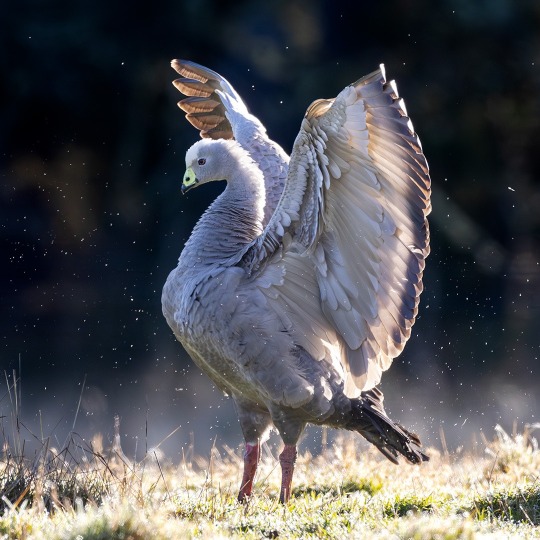
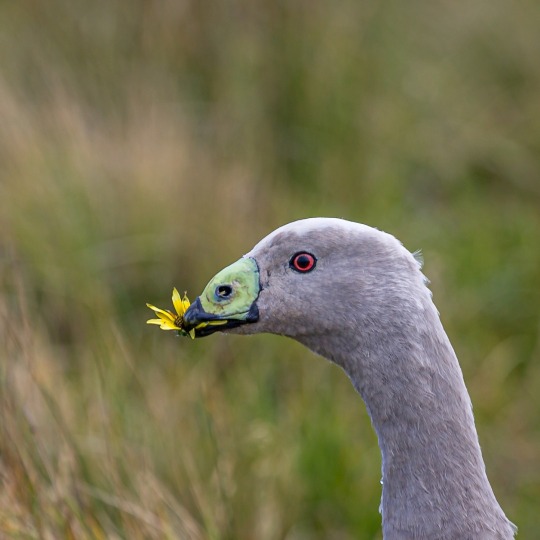
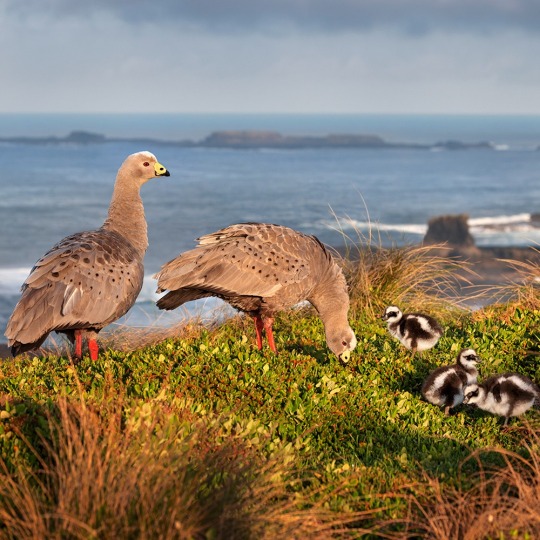

Cape Barren Geese (Cereopsis novaehollandiae), family Anatidae, order Anseriformes, order found in various spotty areas on the southern coast of mainland Australia and Tasmania
photographs by Russel Spence, Jeremy Edwards, Jarryd Guilfoyle, and Tracie Louise (BirdLife Australia)
3K notes
·
View notes
Text
Round 3 - Mammalia - Dasyuromorphia




(Sources - 1, 2, 3, 4)
As marsupials finally made their way into Australia they began to diversify even further. The order Dasyuromorphia represents the vast majority of “carnivorous marsupials”, marsupials which fill the niches of the placental carnivorans. This order contains the living families Dasyuridae (mulgaras, Kaluta, Kowari, quolls, dasyures, Dibbler, marsupial shrews, antechinuses, phascogales, planigales, Kultarr, ningauis, dunnarts, and the Tasmanian Devil) and Myrmecobiidae (the Numbat). Famously, this order also contained the extinct Thylacine (Thylacinus cynocephalus).
Most Dasyuromorphs are small and mouse or shrew-like, though the group also contains the cat-sized quolls and Tasmanian Devil (Sarcophilus harrisii) (image 2). They have many features considered primitive to marsupials, such as seperate toes (in many other marsupials, the second and third toes are fused) and some lack a full pouch. Instead, many species have a simple fold of skin surrounding the teats, to provide some protection to the developing young. Dasyuromorphs are primarily insectivorous, but they will also eat small lizards, birds, frogs, mammals, fruit, nectar, and flowers. One of the few exceptions to this rule is the Tasmanian Devil, which subsists mainly on carrion but can feesibly take on prey up to the size of a small kangaroo. Adult dasyuromorphs are typically solitary, or travel in small groups of two to three individuals.
As in other marsupials, dasyuromorph joeys are born as relatively undeveloped “jellybeans” and must crawl their way from the vagina to the pouch or teat and latch on. Once the young makes contact with the nipple, it expands, locking the joey in place and ensuring it doesn’t fall off the mother or out of the pouch while they finish their development. Smaller dasyuromorphs generally reproduce at least twice a year, but the larger Numbat, quolls, and Tasmanian Devil generally only have one litter a year.
Dasyuromorphs have existed since the Late Oligocene, 33 to 23 million years ago.
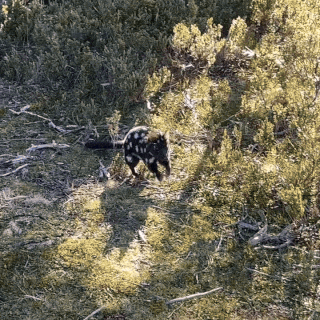
Propaganda under the cut:
Quolls (image 1 and gif) are sometimes referred to as "native cats" and occasionally "marsupial cats" or "tiger cats", due to their cat-like size and behavior.
Although they are nocturnal, the New Guinean Quoll (Dasyurus albopunctatus) is known to spend its daylight hours basking in the sun.
The Paucident Planigale (Planigale gilesi) is also nocturnal and enters a state of torpor in unfavourable conditions to reduce energy expenditure in times of inactivity. However, it also exhibits basking or sunning behavior as an energy-conserving strategy. The Paucident Planigale is the smallest mammal to display basking behavior in the wild in order to reduce energy requirements, particularly in winter.
The Western Quoll (Dasyurus geoffroii) is at the top of the food chain in Western Australia, and eats lizards, birds and their eggs, frogs, spiders, insects, and small mammals, even bandicoots, parrots, and invasive rabbits.
The current major threat to the endangered Northern Quoll (Dasyurus hallucatus) is the spread of the Cane Toad (Rhinella marina). Native to South and mainland Central America, the Cane Toad was introduced by European colonists as biological control of agricultural pests in 1935. The toad was unsuccessful at controlling the targeted cane beetles, but was successful at spreading across Australia and poisoning many of its native predators, who had not evolved alongside the toad to develop a resistance to its toxins or aversion to its taste, and did not recognize it as poisonous. Like many other native Australian predators , Northern Quolls are poisoned after eating or mouthing cane toads. Immediately after the Cane Toad invasion of Kakadu National Park, Northern Quolls became extinct at one study site and declined from 45 individuals to 5 at another site. The Northern Quoll may cease to exist in most areas in the Top End once the Cane Toad population completely overlaps the Northern Quoll's range. Scientists sought to reintroduce quolls who had been trained to avoid the toads, and released them into the park. This was at first successful, however, the quolls had lost their ability to recognise and avoid both feral dogs (dingo) and cats due to being raised in human care, and the population was lost again. Some Northern Quolls persist in Queensland, and seem to naturally be “toad averse,” as well as on islands where the toads have not reached.
The smallest dasyuromorph is the Pilbara Ningaui (Ningaui timealeyi), which is also the smallest of all marsupials, and one of the smallest mammals, averaging 4.5 to 5.8 cm (1.8 to 2.3 in) in body length.
Another tiny dasyuromorph is the Long-tailed Planigale (Planigale ingrami), which averages 5.9 cm in body length and weighs 4-6g. Despite this, it is an active and fearless hunter, preying mostly on insects and their larvae, small lizards, and young mammals almost as large as itself. With larger prey like grasshoppers, an initial pounce is often insufficient and the planigale bites repeatedly until the prey stops struggling.
Following the extinction of the Thylacine in 1936, the Tasmanian Devil (Sarcophilus harrisii) became the largest carnivorous marsupial in the world.
The Tasmanian Devil's large head and neck allow it to generate among the strongest bites per unit body mass of any living predatory land mammal, with a Bite Force Quotient of 181 and exerting a canine bite force of 553 N (124 lbf). The jaw can open to 75–80 degrees, allowing the devil to generate a large amount of power to tear meat and crush bones; sufficient force allows it to bite through thick metal wire. The teeth and jaws of Tasmanian Devils resemble those of hyenas, an example of convergent evolution.
The first European Tasmanian settlers ate Tasmanian Devil, which they described as tasting like veal. As it was believed devils would hunt and kill livestock, a bounty scheme to remove the devil from rural properties was introduced as early as 1830. In areas where devils were eradicated, poultry continued to be hunted by quolls. Over the next 100 years, trapping and poisoning brought Tasmanian Devils to the brink of extinction. More than 900,000 Tasmanian Devils were hunted in 1923—and this resulted in a continuation of bounty hunting of devils as they were thought to be a major threat to the fur industry, even though quolls were more adept at hunting the wallabies and possums typically hunted for fur. After the death of the last Thylacine in 1936, a conservation wake-up call, the Tasmanian Devil was finally protected by law in June 1941 and the population slowly recovered.
Since the late 1990s, devil facial tumour disease (DFTD) has drastically reduced the population of Tasmanian Devils and again threatens the survival of the species, which in 2008 was declared to be endangered. This aggressive, non-viral, clonally transmissible cancer manifests itself as lumps of soft and ulcerating tissue around the mouth, which may invade surrounding organs and metastasise to other parts of the body. DFTD is most often spread by bites, when teeth come into contact with cancer cells. It can also be spread by ingesting of infected carcasses and sharing of food. Adult Tasmanian devils who are otherwise the fittest are most susceptible to the disease. Starting in 2013, Tasmanian Devils are being sent to zoos around the world as part of a Tasmanian Devil conservation and breeding program.
Tasmanian Devils are fully grown at two years of age, and few devils live longer than five years in the wild. Possibly the longest-lived Tasmanian Devil recorded was Coolah, a male devil which lived in human care for more than 7 years. Born in January 1997 at the Cincinnati Zoo, Coolah died in May 2004 at the Fort Wayne Children's Zoo.
Male Little Red Kalutas (Dasykaluta rosamondae), all antechinuses, and many other small dasyurid species die shortly after a frenzied breeding season, probably due to stress or exhaustion. In human care, males can live from 2 to 5 years, but will no longer be able to reproduce after their first year.
The Numbat (Myrmecobius fasciatus) was once widespread across southern Australia, but after the deliberate release of Red Foxes (Vulpes vulpes) by European colonists for sport hunting, the entire Numbat population in Victoria, NSW, South Australia and the Northern Territory, and almost all Numbats in Western Australia were wiped out. It is now restricted to several small colonies in Western Australia. By the late 1970s, the population was well under 1,000 individuals. An intensive research and conservation program since 1980 has succeeded in increasing the Numbat population substantially, and reintroductions to fox-free areas have begun. Perth Zoo is very closely involved in breeding this native species in captivity for release into the wild.
As an adaptation to a diet consisting almost entirely of termites, the Numbat has a long, sticky anteater-like tongue which it uses to catch its prey. Although the Numbat finds termite mounds primarily using scent, it has the highest visual acuity of any marsupial, and, unusually for marsupials, has a high proportion of cone cells in the retina.
Every night the Fat-tailed Dunnart (Sminthopsis crassicaudata) consumes approximately its own body weight in food. During periods of food shortage it decreases its duration of activity while also increasing its intensity of feeding. It uses specialized, sharp teeth to grind its prey into fine pieces.
The Thylacine (Thylacinus cynocephalus) was the last of the Thylacinids, a family of dasyuromorph marsupials. It lived from the Pleistocene to the Holocene in Australia and New Guinea, driven to extinction in the 1930s by hunting, human encroachment, disease, and feral dogs (dingos). The Thylacine was already extinct on the Australian mainland and New Guinea by the time European settlers arrived, with the island of Tasmania being its last stronghold. Settlers feared the marsupial would attack them and their livestock, demonizing it as a “blood drinker”, and bounties were put in place that drove the Thylacine to be overhunted. As they became rarer, there was a push to capture Thylacines and keep them alive in captivity, but unfortunately it was too little, too late. Conservation and animal welfare was not at the level it is today, not much was known about their behavior in the wild, and there was only one successful birth in captivity. Studies show that with continued successful breeding, a campaign to change public perception, and protections put into place much earlier, the Thylacine could have been saved. But the last captive Thylacine died in 1936, and official protection was not put in place until that year, 59 days before his death. Sightings continued into the 1980s, and even today some claim to see them, but all of these sightings are unconfirmed and unlikely. The Thylacine is definitively extinct. Today, carnivores such as wolves and coyotes are demonized in the same way the Thylacine was, and there are some who wish to also wipe them out entirely, even having succeeded in many places. While some of the Thylacine’s closest relatives, like the Numbat and Tasmanian Devil, survived the European persecution which killed off the Thylacines, they are still endangered today due to introduced predators and disease. Instead of continuing to search for, or trying to resurrect the lost Thylacine, perhaps it is best we channel that attention, love, and regret onto the species we still have. Extinction is forever, and it is easier to save those who are still alive.

(source)
#i apologize for reusing my spiel from my Thylacine post on my paleoart account but I think it’s very important#stop trying to de-extinct species when those resources could be better used on species we still have and have a better chance of saving#animal polls#round 3#mammalia
114 notes
·
View notes
Text
TIL the Australian guy that put on the single greatest piece of improv theater ever caught on camera during his wrongful arrest passed away this August from cancer.
youtube
For those who don't know: in 1991 an investigator who suspected this man of credit card fraud called the cops on him at the Chinese restaurant where he was dining with a friend. To expedite the arrest, he led the police to believe they were arresting a high profile criminal of some sort.
Police surrounded the restaurant, corralled the waiting media (who had somehow gotten wind), and interrupted Karlson's lunch.
"He was as calm as anything," former police detective Adam Firman says of the moment he arrested Karlson in the restaurant.
"He was happy to go with us. Well, as happy as you can be, to be arrested. Until he saw all the media. And that's when he just went berserk."
The lines Karlson delivered have since become classic quotes in internet culture.
"Gentlemen, this is democracy manifest!" Karlson declares to the cameras as he's wrestled into the police car.
...
"As soon as we drove away, he stopped and he said, 'That was fun,'" Firman says.
"There was no fight getting him out of the car. Nothing. It was all put on for the cameras."
The drama behind the rant
The Brisbane police who arrested him that day didn't know that Karlson had been a criminal and a serial prison escapee. He was also a part-time actor.
By the time he was 34, Karlson had spent most of his life in homes and prisons.
His first escape was in 1966. He was on a train going from Boggo Road Gaol to face a breaking, entering and stealing charge at Maryborough Magistrates Court. He got out of his handcuffs and jumped off.
Two years later, after he had been locked up in McLeod Prison Farm on Victoria's French Island for another theft, he convinced a local fisherman to give him a lift to the mainland.
Three months after that, he was picked up in a stolen car carrying safe-breaking tools in Parramatta. Just before his trial, he impersonated a detective and walked out of his court cell. Finally, he was captured in an apartment on Sydney's North Shore.
That's when his life took a dramatic left turn.
Sentenced to eight years in Parramatta Gaol, Karlson was put in an unusually large cell with an inmate named Jim McNeil.
This chance encounter would become destiny manifest.
McNeil had heard about Karlson impersonating a detective, and he thought it was hilarious.
He welcomed Karlson into his cell. The two men bonded over making foul-tasting alcohol in the cell's washbasin from raisins and yeast, and shared histories.
They had both grown up poor, even by the standards of their rough-and-tumble neighbourhoods. Adults had abused them physically and sexually. And they'd both stolen and scammed a few shillings for their families when they saw the chance.
After encouragement from Karlson, McNeil wrote a play about cellmates who brewed grog. They put it on in prison, and Karlson played a leading role.
Both had discovered talents they didn't know they had. McNeil kept writing on his smuggled typewriter, and Karlson kept acting. The plays became a hit among young Sydney intellectuals, many who had been campaigning for prisoners' rights.
Within four years, their work got them out on parole a combined 13 years early.
Best friends
Karlson and McNeil's friendship continued outside the prison gates and they moved into a house in Richmond together.
The two men stuck out like sore thumbs in their new-found scene of artists and intellectuals.
Neither man had set foot in a theatre, but McNeil's plays were already being performed across Australia. He felt that, with the success of his plays, he'd never need to resort to crime again. On radio and in the press, he would give didactic rants about the brutality of the justice system.
Karlson, meanwhile, got parts in the prime-time crime dramas Homicide and Matlock Police.
They remained close.
"The lovely bloke. I love him," McNeil told an interviewer around the same time Karlson named his son Jim McNeil Karlson.
Karlson described them as best friends.
But McNeil's alcoholism killed him in 1982.
Karlson couldn't travel to the funeral in Sydney for legal reasons.
"I … with a bodgie [fake identity], booked up hundreds and hundreds of dollars worth of flowers and wreaths," he says.
Final days
McNeil's plays weren't subtle. They were screeds aimed at a society that arrested and tormented unfortunate men for petty crimes.
"The message is: look what you're doing to people," he told one interviewer.
He went on to tell a story about an Aboriginal cellmate. "He was illiterate, he was poor. He had nothing. And he stole thruppence ha'penny. And then he got three and a half years. That's a penny a year.
"Prison is the best way to show what's wrong with the outside."
His final play was about two cellmates in Parramatta. He named it 'Jack', and finished it in a drunken haze.
"Do you know I'm here?" shouts Jack the character. "Do you give a f*** where I am? No. No, you don't give a f*** where I am. Pricks. Democrats."
Fifteen years later, Jack Karlson declared "Gentlemen, this is democracy manifest!" to the waiting cameras and an enduring audience.
It would be his most unforgettable performance.
From 7news:
So how did Karlson improvise a performance so poetic, so theatrical and so amusing?
“Of course, I was somewhat influenced by the juice of the red grape."
Karlson spent his last years as a painter, incidentally selling many paintings of his own infamous arrest, and helping make a documentary about his life that's yet to be released. He died aged 82, surrounded by family and was widely mourned.
"Tata and farewell" legend. Hope the internet never forgets you. ACAB forever.
#jack karlson#this narrates in my head whenever i stuff my cats in the carrier to take them to the vet#'I'm under WHAT? What is the charge?? Eating a meal? a succulent fish meal??'#'gentlemen this is democracy meownifest!'#also always deeply freaked out by how much he looks like my Dad#complete with Type A Main Character Personality 😂#memes#funny#australia#laugh tag#wtf news#knee of huss#Youtube
132 notes
·
View notes